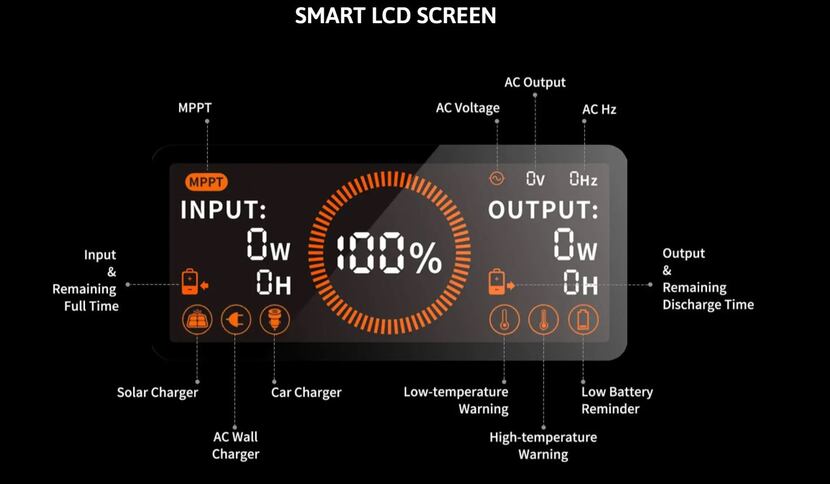The winter storm and subsequent power outages in Texas in February brought a lot of attention to gas-powered generators and portable power stations.
I’ve reviewed more than a few portable power stations, which are large batteries that store energy and convert it to usable electricity.
When the power goes out, it is natural to just wait and wonder whether the outage will be brief or lengthy.
If the outage is due to severe weather, you have a little notice. When we’re expecting storms, my wife and I will light a candle or two and get the flashlights out and placed around the house.
If the outage lasts for more than 10 to 15 minutes, I start thinking about getting out a portable power station.
Of course, the time of day dictates our power needs.
If the power goes out at 9 a.m., lights are not a priority. If the power goes out at 9 p.m., I’ll start worrying about lights and what we need during the night.
I sleep with a CPAP machine, so a power station with enough juice to keep it going all night is important.
Air temperature is also an important factor.
The frigid temperatures during the winter storms meant powering a portable heater was a priority.
So our needs are variable, but almost everyone will find that a power station is handy during an outage.
Solar generator?
Until this year, the largest Jackery portable power station was the Explorer 1000, but a few weeks ago, the company introduced the Explorer 1500 and Explorer 2000. I was sent the 1500 to review, along with four of the Jackery SolarSaga 100 solar panels ($2,699 for the bundle).
A quick note here: Jackery considers the bundle of power station and solar panels to be a solar generator. The bundle is called the Solar Generator 1500.
Whenever I’ve used the term generator to refer to a power station, I’ve received emails from readers telling me a big battery with power outlets is not a generator, and they are correct. The battery is eventually used up and you need to fill it again.

The addition of solar panels means you can collect power from the sun, store that energy in the battery and use it up through the output ports.
The process can be a bit tedious.
Compared with a gas generator that just needs fuel to keep running, the 1500 can only really be charged when the sun is out, and you have to keep moving the panels throughout the day to face the sun for the fastest charging.
Of course, there are some other differences that make the Jackery a more compelling choice.
Gas generators are noisy and you have to keep them outside, running extension cords inside to power your stuff.
The Jackery is clean and quiet and can be run indoors. Since it doesn’t have a gasoline engine, you can run it in your bedroom and not disturb your sleep. It also needs no maintenance and there is no ongoing cost for consumable fuel, oil and spark plugs.
For a true off-the-grid experience, solar generators can work anywhere you can see the sun. You don’t have to keep a supply of gasoline on hand.
There are situations where gas generators are a better option, and other times when solar generators are better. Figuring out which will work best for your situation is up to you.
Specs
The Jackery Solar Generator 1500 bundle comes in five big boxes — one for the power station and four solar panels. Once you unbox everything, it becomes a lot easier to store.
The power station can charge from solar panels, from a 12-volt car adapter or from AC power.
The 12-volt car adapter takes the longest to fill the battery at 13 hours.
The four 100-watt solar panels combine to charge the 1500 in about five hours.
If you drop down to two solar panels, the charge time extends to 9.5 hours.
The included AC adapter can charge the battery in six hours, and if you buy a second AC adapter (you can plug two AC adapters in for the fastest charge), the charge time drops to a very impressive 3.5 hours. Jackery says two AC adapters will charge the 1500 from zero to 80% in two hours.
The battery has a capacity of 1,488 watt-hours and an estimated lifespan of eight years, according to Jackery.
The Explorer 1500 weighs 33 pounds and is the size of a small drink cooler (14 by 10.4 by 12.7 inches).
It can operate in temperatures ranging from 14 to 104 degrees.
It has three AC outlets connected to an inverter that can provide 1,800 watts of power. The pure sine wave inverter can also provide up to 3,600 watts for peak bursts. This is needed when you are powering something like a refrigerator with a motor. When motors turn on, they use a burst of power and then level out.
There are two USB-A ports, one that can provide 2.4 amps of power and one that’s a Quick Charge 3.0 output with up to 18 watts of power.
There is also one USB-C port with power delivery that can provide up to 60 watts.
The 12-volt car output plug provides 120 watts (12 volts at 10 amps).
You can have something plugged into all seven outputs at once and you can also be charging the batteries while you use the power station.
This is called pass-through power. It works like an uninterruptible power supply for a computer.
In my case, I can keep my CPAP plugged into the Jackery and keep it plugged into the wall. If the power goes out, the battery will kick in and will keep the CPAP running without interruption.

The 1500 has a color screen to show you what is going on with the power.
There are readings for power input and output as well as the expected times for charging and how long the battery will last with the current load. All the readings change when the conditions change and everything is very accurate.
What can it power?
The simplest way to explain the power capacity of a power station is to think in watt-hours.
The battery has a capacity of 1,488 watt-hours. This means it can run a 1,500-watt appliance for approximately one hour before the batteries need recharging.
We have a 1,500-watt hair dryer at my house. I can run that hair dryer for one hour.
Our 1,200-watt microwave can run for about 70 minutes.
To figure out your run times, figure out how any watts your appliances use and do some math.
The formula is 1,488Wh x 0.085/operating wattage of your device.
Gadgets that have motors or generate heat use the most power, so they don’t last nearly as long as something like LED lights or recharging a phone.
A few more examples include about 16 recharges for a MacBook, 136 charges for a smartphone and 23 to 105 hours for my CPAP (depending on whether I use the heated water chamber).
SolarSaga 100
The solar panels are why this bundle can work off the grid.
The panels are rigid and fold in half for storage. Unfolded, the panel is 24 by 48 inches and it has adjustable props like a picture frame to sit upright to face the sun. It weighs about 9 pounds.

The Explorer 1500 has two power inputs.
To use four solar panels, you’ll have to use two parallel adapters, which are small dongles with inputs for two panels. This setup allows you to connect four solar panels to the two power inputs on the power station.
You can also use the panels individually to power the Explorer 1500 (one panel charges at 25% of the rate of four panels). The panels also have one USB-A and one USB-C port to directly charge phones or other USB devices.
In use
The Explorer 1500 is super simple to charge and use. Of course, plugging it into the wall is the fastest way to charge, but to get the maximum use from the battery, you need to be able to charge it when the power is out.
I realize the bundle is expensive. It is possible to get smaller power stations and fewer or smaller solar panels.
The capacity needs of your home might be different from mine. Your budget will help determine how much capacity you can afford.
This is a lot of money to spend on something you hope to not use. Nobody wants their power to go out.
A couple of uses I haven’t mentioned are for camping or for powering tools or appliances when you’re out working and power outlets are not convenient. This would be a really nice setup for someone who works in construction, especially on job sites where electricity is not yet installed.
Pricing and availability
The Jackery Solar Generator 1500 bundle will be available on April 5, and supplies will be limited.
Be on the lookout for discounts on Jackery’s website for early-bird orders.
The Explorer 1500 is available separately for $1,599, and the SolarSaga 100 panels are available for $299 each.
Pros: Large capacity, lots of outputs, fast charging.
Cons: Expensive. Recharging from the sun is a bit cumbersome.
Bottom line: The Jackery bundle works well to keep the energy flowing off the grid.

